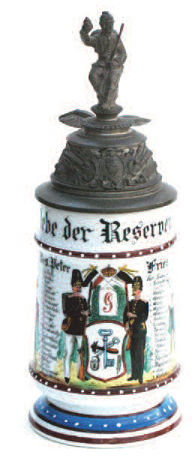
Regimental Steins
Souvenirs of German Military Service

Regimental Steins
Souvenirs of German Military Service

This short article is excerpted from a brochure titled "Collecting Beer Steins: An Introduction to the hobby" which was prepared under the guidance of R. Ron Heiligenstein, SCI Master Steinologist and author of "Regimental Beer Steins (Reservistenkrüge) 1890 - 1914".
The
German Constitution of 1871 reaffirmed that all able-bodied men were
liable for military service. Due to financial constraints, however,
less than half of those qualified actually served in the standing army.
At that time some servicemen, just prior to the completion of their
time in training, purchased a souvenir "in remembrance of my service
time." Often this was a stein made from porcelain, pottery, stoneware
or glass decorated in a motif symbolizing the soldier's branch of
service and personalized with his name, garrison town, military unit
designation and his years of service. Each regimental stein tells a
complete story and every facet of the stein is symbolic. The finial
relates to the type of unit, with cannon depicting the artillery; a
seated soldier, the infantry; and a horse and rider with a lance, the
cavalry. The thumblift is also part of the story: A rampant lion
depicts Bavaria or Hesse; an eagle, Prussia; and the griffin, Baden.
The body of a regimental stein usually has a central scene and two or
more smaller side scenes. Many steins have a roster, usually near the
handle, listing the names of the reservists in the original owner's
unit. Most porcelain regimentals have lithophanes with domestic,
farewell or royalty scenes. If a regimental stein has either a
lithophane with a nude scene or a small bulge inside the curve of the
handle, the stein is most probably a reproduction. If the pewter lid
has the same patina inside and out and the body shows no indication of
any enamel highlighting, the stein is possibly a reproduction.
The porcelain regimental stein seen at right displays a characteristic
pewter finial. These steins are detailed recordings of history. Germany
became a major world power in the late 19th century.